warning SUZUKI JIMNY 2020 User Guide
[x] Cancel search | Manufacturer: SUZUKI, Model Year: 2020, Model line: JIMNY, Model: SUZUKI JIMNY 2020Pages: 421, PDF Size: 6.35 MB
Page 29 of 421
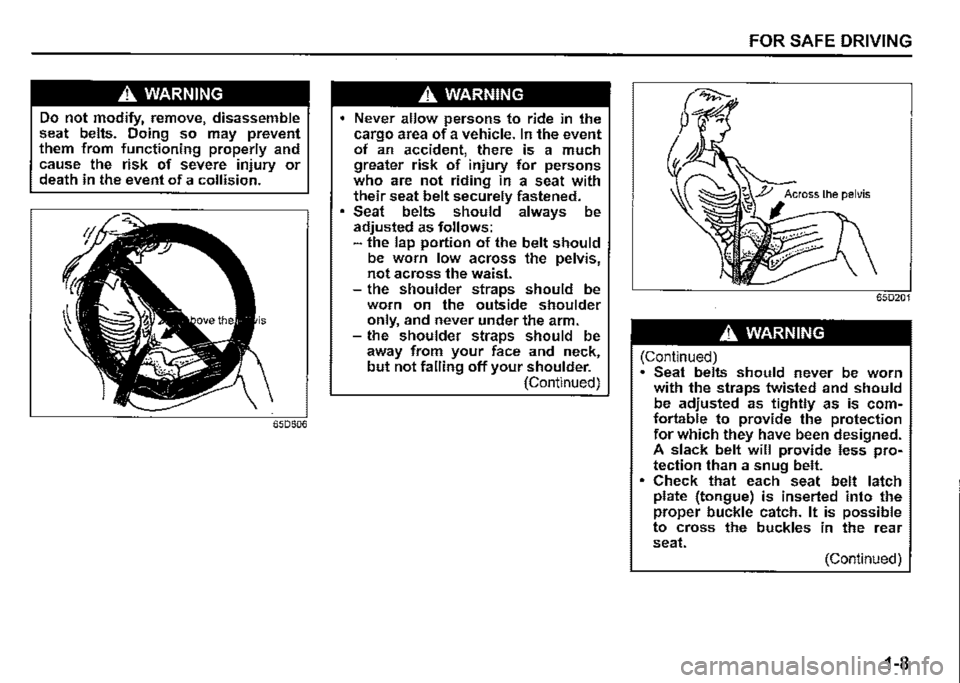
A WARNING
Do not modify, remove, disassemble seat belts. Doing so may prevent them from functioning properly and cause the risk of severe injury or death in the event of a collision.
A WARNING
Never allow persons to ride in the cargo area of a vehicle. In the event of an accident, there is a much greater risk of injury for persons who are not riding in a seat with their seat belt securely fastened. Seat belts should always be adjusted as follows: -the lap portion of the belt should be worn low across the pelvis, not across the waist. -the shoulder straps should be worn on the outside shoulder only, and never under the arm. -the shoulder straps should be away from your face and neck, but not falling off your shoulder. (Continued)
FOR SAFE DRIVING
65D201
A WARNING
(Continued) • Seat belts should never be worn with the straps twisted and should be adjusted as tightly as is comfortable to provide the protection for which they have been designed. A slack belt will provide less protection than a snug belt. Check that each seat belt latch plate (tongue) is inserted into the proper buckle catch. It is possible to cross the buckles in the rear seat. (Continued)
1-8
Page 30 of 421
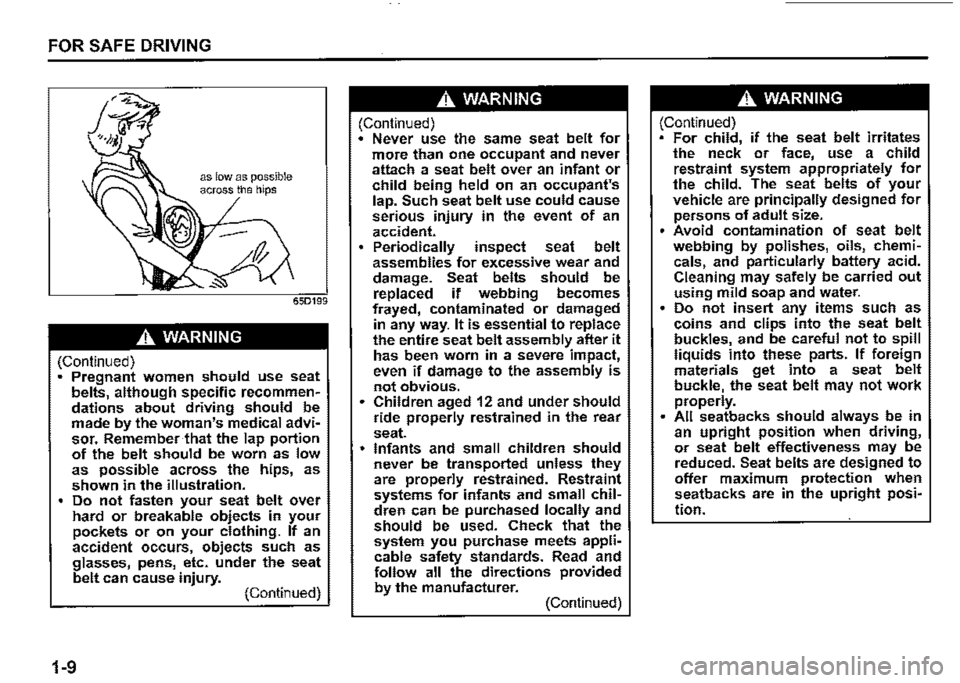
FOR SAFE DRIVING
A. WARNING
(Continued) Pregnant women should use seat belts, although specific recommendations about driving should be made by the woman's medical advi• sor. Remember that the lap portion of the belt should be worn as low as possible across the hips, as shown in the illustration. Do not fasten your seat belt over hard or breakable objects in your pockets or on your clothing. If an accident occurs, objects such as glasses, pens, etc. under the seat belt can cause injury. (Continued)
1-9
A. WARNING
(Continued) • Never use the same seat belt for more than one occupant and never attach a seat belt over an infant or child being held on an occupant's lap. Such seat belt use could cause serious injury in the event of an accident. Periodically inspect seat belt assemblies for excessive wear and damage. Seat belts should be replaced if webbing becomes frayed, contaminated or damaged in any way. It is essential to replace the entire seat belt assembly after it has been worn in a severe impact, even if damage to the assembly is not obvious. Children aged 12 and under should ride properly restrained in the rear seat. Infants and small children should never be transported unless they are properly restrained. Restraint systems for infants and small chil• dren can be purchased locally and should be used. Check that the system you purchase meets appli• cable safety standards. Read and follow all the directions provided by the manufacturer. (Continued)
A. WARNING
(Continued) For child, if the seat belt irritates the neck or face, use a child restraint system appropriately for the child. The seat belts of your vehicle are principally designed for persons of adult size. Avoid contamination of seat belt webbing by polishes, oils, chemi• cals, and particularly battery acid. Cleaning may safely be carried out using mild soap and water. • Do not insert any items such as coins and clips into the seat belt buckles, and be careful not to spill liquids into these parts. If foreign materials get into a seat belt buckle, the seat belt may not work properly. All seatbacks should always be in an upright position when driving, or seat belt effectiveness may be reduced. Seat belts are designed to offer maximum protection when seatbacks are in the upright posi•
tion.
Page 33 of 421

(1)
(1) Correct (2) Wrong
78RB02085
A WARNING
When fastening the rear seat belt, always use the closest buckle to you. If you use the buckle for your next rear seat position by mistake, the rear seat belt may not function properly.
FOR SAFE DRIVING
Unfastening To unfasten the seat belt, push the button on the buckle (3) and retract the belt slowly while attaching a hand to the belt or/and the latch plate.
61MM0A061
61MM0A062
1-12
Page 34 of 421
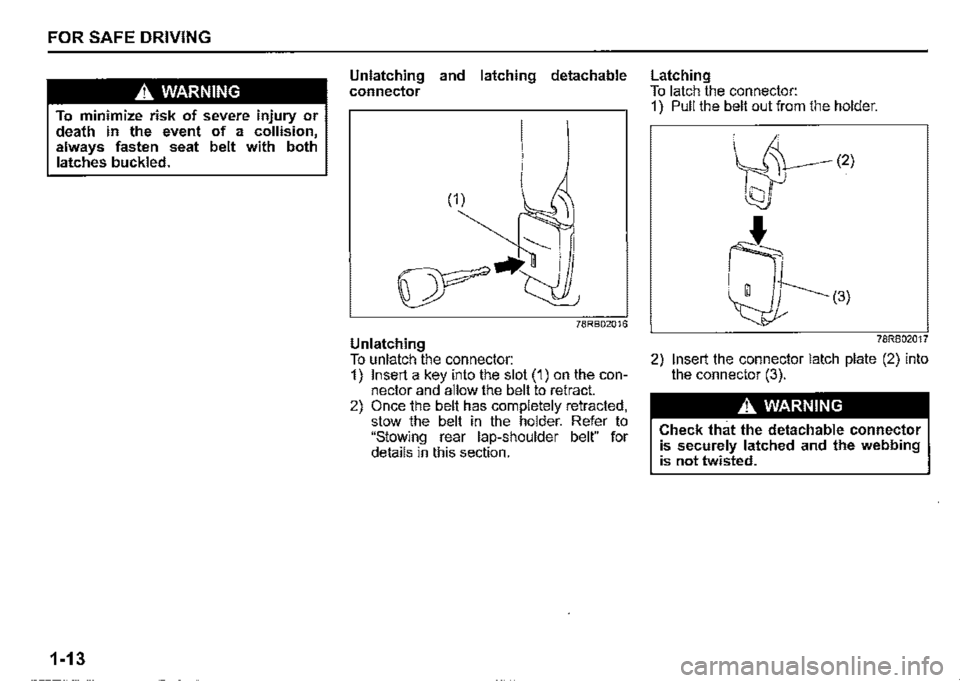
FOR SAFE DRIVING
A WARNING
To minimize risk of severe injury or death in the event of a collision, always fasten seat belt with both latches buckled.
1-13
Unlatching and latching detachable connector
Unlatching To unlatch the connector: 1) Insert a key into the slot (1) on the connector and allow the belt to retract. 2) Once the belt has completely retracted. stow the belt in the holder. Refer to "Stowing rear lap-shoulder belt"" for
details in this section.
Latching To latch the connector: 1) Pull the belt out from the holder.
78RB02017
2) Insert the connector latch plate (2) into the connector (3).
A WARNING
Check that the detachable connector is securely latched and the webbing is not twisted.
Page 36 of 421
![SUZUKI JIMNY 2020 User Guide FOR SAFE DRIVING
Seat belt reminder
Instrument cluster (Type A)
L 00[]
Instrument cluster (Type B)
1-15
R
78RB02019
(1) Drivers seat belt reminder light/ front passengers seat belt reminder SUZUKI JIMNY 2020 User Guide FOR SAFE DRIVING
Seat belt reminder
Instrument cluster (Type A)
L 00[]
Instrument cluster (Type B)
1-15
R
78RB02019
(1) Drivers seat belt reminder light/ front passengers seat belt reminder](/img/20/43483/w960_43483-35.png)
FOR SAFE DRIVING
Seat belt reminder
Instrument cluster (Type A)
L 00[]
Instrument cluster (Type B)
1-15
R
78RB02019
(1) Driver's seat belt reminder light/ front passenger's seat belt reminder light (2) Rear passenger's seat belt reminder light (rear left)*1
(3) Rear passenger's seat belt reminder light (rear right)'2
•1 This symbol represents that the seat belt is unfastened. •2This symbol represents that the seat belt is fastened.
When the driver and/or passenger(s) do not fasten their seat belts, the seat belt reminder lights will come on or blink and a buzzer will sound to remind the driver and/ or passenger(s) to fasten their seat belts. For more details, refer to the explanation below.
A. WARNING
It is absolutely essential that the driver and passengers fasten their seat belts at all times. Persons who are not fastening seat belts have a much greater risk of injury if an accident occurs. Make a regular habit of buckling your seat belt before putting the key in the ignition.
Page 38 of 421

FOR SAFE DRIVING
Seat belt hanger
NOTICE
When you move a seatback, make sure the belt webbing is hooked in the seat belt hangers so the seat belts are not caught by the seatback, seat hinge, or seat latch. This helps prevent damage to the belt system.
1-17
Seat belt inspection
65D209S
Periodically check if the seat belts work properly and are not damaged. Check the webbing, buckles, latch plates, retractors, anchorages and guide loops. Replace any seat belts which do not work properly ·or
are damaged.
A WARNING
Inspect all seat belt assemblies after any collision. Any seat belt assembly which was in use during a collision (other than a very minor one) should be replaced, even if damage to the assembly is not obvious. Any seat belt assembly which was not in use during a collision must be replaced if the airbags and the seat belt pretensioners activated. The airbags, the pretensioners and the load limitter will only function once. In case they did not activate, consult with Suzuki dealer.
Page 40 of 421

FOR SAFE DRIVING
58MS030
A WARNING
(Vehicle without the front passenger airbag deactivation system) Do not install a rear-facing child restraint in the front passenger's seat. If the passenger's front airbag inflates, a child in a rear-facing child restraint could be killed or severely injured. The back of a rear-facing child restraint would be too close to the inflating airbag.
1-19
A WARNING
(Vehicle with the front passenger airbag deactivation system) When using a child restraint system on the front passenger's seat, the front passenger's airbag system must be deactivated; otherwise deployment of the front passenger's airbag could result in the death or serious injury of the child.
A WARNING
If you install a child restraint system in the rear seat, slide the front seat far enough forward so that the child's feet do not touch the front seatback. This will help avoid injury to the child in the event of an accident.
65D609
A WARNING
Children could be endangered in a collision if their child restraint systems are not properly secured in the vehicle. When installing a child restraint system, follow the instructions below. Secure the child in the restraint system according to the manufacturer's instructions.
Page 50 of 421
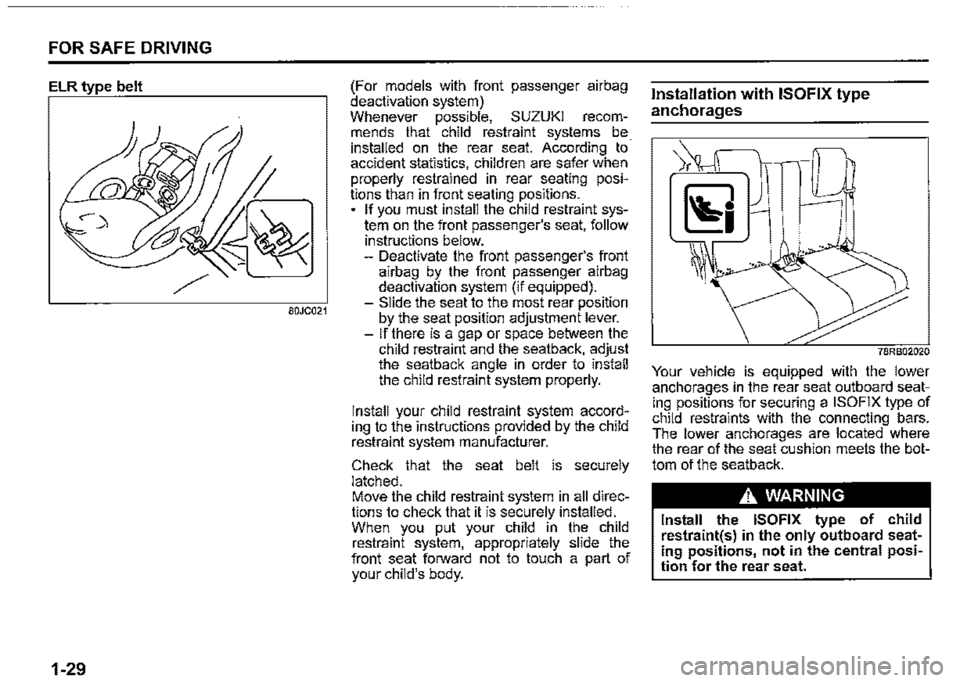
FOR SAFE DRIVING
ELR type belt
80JC021
1-29
(For models with front passenger airbag deactivation system) Whenever possible, SUZUKI recommends that child restraint systems be installed on . th_e rear seat. According to· accident stat1st1cs, children are safer when ~roperly restrained in rear seating positions than in front seating positions. • If you must install the child restraint system on the front passenger's seat follow instructions below. ' -D_eactivate the front passenger's front airbag by the front passenger airbag d~activation system (if equipped). -Slide the seat to the most rear position by the seat position adjustment lever. -If there is a gap or space between the child restraint and the seatback, adjust the seatback angle in order to install the child restraint system properly.
Install your child restraint system according to the instructions provided by the child restraint system manufacturer.
Check that the seat belt is securely latched. Move the child restraint system in all directions to check that it is securely installed. When you put your child in the child restraint system, appropriately slide the front seat forward not to touch a part of your child's body.
Installation with ISOFIX type
anchorages
78RB02020
Your vehicle is equipped with the lower anchorages in the rear seat outboard seating positions for securing a ISOFIX type of child restraints with the connecting bars. The lower anchorages are located where the rear of the seat cushion meets the bottom of the seatback.
A WARNING
Install the ISOFIX type of child restraint(s) in the only outboard seating positions, not in the central position for the rear seat.
Page 53 of 421
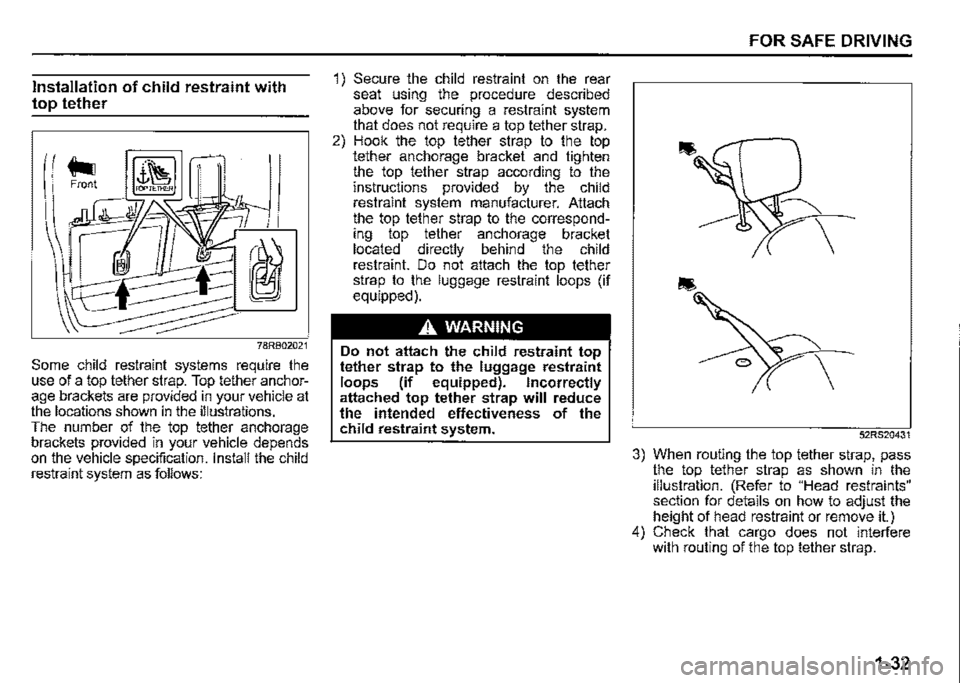
Installation of child restraint with
top tether
78RB02021
Some child restraint systems require the use of a top tether strap. Top tether anchorage brackets are provided in your vehicle at the locations shown in the illustrations. The number of the top tether anchorage brackets provided in your vehicle depends on the vehicle specification. Install the child restraint system as follows:
1) Secure the child restraint on the rear seat using the procedure described above for securing a restraint system that does not require a top tether strap. 2) Hook the top tether strap to the top tether anchorage bracket and tighten the top tether strap according to the instructions provided by the child restraint system manufacturer. Attach the top tether strap to the corresponding top tether anchorage bracket located directly behind the child restraint. Do not attach the top tether strap to the luggage restraint loops (if equipped).
A WARNING
Do not attach the child restraint top tether strap to the luggage restraint loops (if equipped). Incorrectly attached top tether strap will reduce the intended effectiveness of the child restraint system.
FOR SAFE DRIVING
52RS20431
3) When routing the top tether strap, pass the top tether strap as shown in the illustration. (Refer to "Head restraints" section for details on how to adjust the height of head restraint or remove it.) 4) Check that cargo does not interfere with routing of the top tether strap.
1-32
Page 54 of 421

FOR SAFE DRIVING
NOTICE
When installing a child restraint system to the rear seat, adjust the front seat position so that the front seat does not interfere with the child restraint system.
NOTE: For Australian models, refer to "For Australia" in the "SUPPLEMENT" section.
1-33
Seat belt pretensioner system
A WARNING
This section describes your SUZUKI vehicle's seat belt pretensioner system. Read and follow all these instructions carefully to minimize your risk of severe injury or death.
To determine if your vehicle is equipped with a seat belt pretensioner system at the front or rear seating positions, check the label on the seat belt at the bottom part. If the letters "p" and/or "PRE" appear as illustrated, your vehicle is equipped with the seat belt pretensioner system. You can use the pretensioner seat belts in the same manner as ordinary seat belts. Read this section and "Supplemental restraint system (airbags)" section to learn more about the pretensioner system.
The seat belt pretensioner system works with the supplemental restraint system (airbags). The crash sensors and the electronic controller of the airbag system also control the seat belt pretensioners. The pretensioners are triggered only when there is a frontal or side collision severe enough to trigger the airbags and the seat belts are fastened. For precautions and general information including servicing the pretensioner system, refer to "Supplemental restraint system (airbags)" section in addition to this "Seat belt pretensioner system" section, and follow all those precautions.